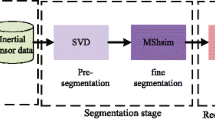Abstract
The segmentation of motion capture data is essential for the synthesis of motion data, its purpose is to split long movement sequence data into many different independent semantic motion clips, and it requires that the segmentation of motion capture data is effective and accurate. This paper proposed a segmentation algorithm of motion capture data based on measured MDS and improved oblique space distance. The proposed approach used the multidimensional scaling (MDS) to achieve the space mapping from original high-dimensional data to low-dimensional, and then calculated the improved oblique space distance between frames in the specified windows and the preceding section in the low-dimensional space, and obtained the final segmentation points by similarity detection. Finally we obtained the independent semantic motion clips, and we verified the feasibility of the algorithm through experiments, and the accuracy rate of our method is improved compared with the traditional algorithm.
Access this chapter
Tax calculation will be finalised at checkout
Purchases are for personal use only
Similar content being viewed by others
References
Kahol, K., Tripathi, P., Panehanathan, S.: Gesture segmentation in complex motion sequences. In: Proceedings of IEEE International Conference on Image Processing, pp. II–105–108. IEEE (2003)
Kahol, K., Tripathi, P., Panchanathan, S.: Automated gesture segmentation from dance sequences. In: 6th IEEE International Conference, pp. 883–888. IEEE (2004)
Zhou, F., Torre, F.D., Hodgins, J.K.: Aligned cluster analysis for temporal segmentation of human motion. In: 8th IEEE International Conference on Automatic Face and Gesture Recognition, pp. 1–7. IEEE (2008)
Balci, K., Akarun, L.: Clustering poses of motion capture data using limb centroids. In: 23rd International Symposium on Computer and Information Sciences, pp. 1–6. IEEE(2008)
Barbic, J., Safonova, A., Pan, J.Y., et al.: Segmenting motion capture data into distinct behaviors. In: Proceedings of Graphics Interface, pp. 185–194. Canadian Human-Computer Communications Society, Canada (2004)
Qu, S., Yu, R.H., Wu, L.D., et al.: Automatic segmentation of motion capture data based on latent space. Appl. Res. Comput. 28(8), 3128–3130 (2011)
Jing, S.X., Wu, Z., Huang, Z.Y.: Segmenting single actions from continuous capture motion sequence. In: 2009 WRI World Congress on Computer Science and Information Engineering, pp. 85–89. IEEE, Los Angeles (2009)
Peng, S.J.: Motion segmentation using central distance features and low-pass filter. In: International Conference on Computational Intelligence and Security, pp. 223–226. USA (2010)
Xiao, J., Zhang, Y.T., Wu, F.: Feature visualization and ineranctive segmentation of 3D human motion. J. Softw. 8(19), 1995–2003 (2008)
Xiao, J., Zhang, Y.T., Wu, F., et al.: A group of novel approaches and a toolkit for motion capture data reusing. Multimedia Tools Appl. 47(30), 379–408 (2010)
Chattopadhyay, S., Bhandarkar, S.M., Li, K.: Human motion capture data compression by model-based indexing: a power aware approach. Vis. Comput. Graph. 13(1), 5–14 (2007)
Salamah, S., Zhang, L., Brunnett, G.: Hierarchical method for segmentation by classification of motion capture data. In: Brunnett, G., Coquillart, S., van Liere, R., Welch, G., Váša, L. (eds.) Virtual Realities. Lecture Notes in Computer Science, vol. 8844, pp. 169–186. Springer International Publishing, Switzerland (2015)
Lin, J.F.S, Kulic, D.: Segmenting human motion for automated rehabilitation exercise analysis. In: 2012 Annual International Conference of the IEEE Engineering in Medicine and Biology Society (EMBC), pp. 2881–2884. IEEE (2012)
Orrite, C., Rodriguez, M., et al.: Automatic segmentation and recognition of human actions in monocular sequences. In: 22nd International Conference on Pattern Recognition of the IEEE, pp. 4218–4223. IEEE (2014)
Wu, X.T., Yan, D.Q.: Analysis and research on method of data dimensionality reduction. Appl. Res. Comput. 26(8), 2832–2835 (2009)
Cox, T.F., Cox, M.A.A.: Multidimensional Scaling. CRC Press, New York (2000)
Vander Maaten, L.J., Postma, E.O., van den Herik, H.J.: Dimensionality reduction: a comparative review. J. Mach. Learn. Res. 10(1–41), 66–71 (2009)
Peng, S.J., Liu, X.: Double-feature combination based approach to motion capture data behavior segmentation. Comput. Sci. 40(8), 303–308 (2013)
Acknowledge
This work is supported by the National Natural Science Foundation of China (No.61370141, 61300015), Natural Science Foundation of Liaoning Province (No. 2013020007), the Scientific Research Fund of Liaoning Provincial Education Department (No. L2013459, L2015015), the Program for Science and Technology Research in New Jinzhou District (No. KJCX-ZTPY-2014-0012).
Author information
Authors and Affiliations
Corresponding author
Editor information
Editors and Affiliations
Rights and permissions
Copyright information
© 2015 Springer International Publishing Switzerland
About this paper
Cite this paper
Song, D., Dong, J., Zhang, Q. (2015). Segmentation of Motion Capture Data Based on Measured MDS and Improved Oblique Space Distance. In: Bikakis, A., Zheng, X. (eds) Multi-disciplinary Trends in Artificial Intelligence. MIWAI 2015. Lecture Notes in Computer Science(), vol 9426. Springer, Cham. https://doi.org/10.1007/978-3-319-26181-2_17
Download citation
DOI: https://doi.org/10.1007/978-3-319-26181-2_17
Published:
Publisher Name: Springer, Cham
Print ISBN: 978-3-319-26180-5
Online ISBN: 978-3-319-26181-2
eBook Packages: Computer ScienceComputer Science (R0)




